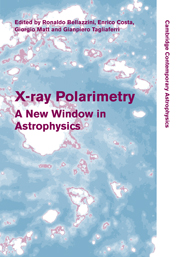Preface
Published online by Cambridge University Press: 06 July 2010
Summary
Advances in X-ray astronomy over the almost five decades since the first rockets were launched have been impressive in the domains of imaging, spectroscopy and timing. On the contrary, polarimetry has not progressed much since the historic results of the Columbia team headed by Bob Novick with rockets and with the OSO-8 satellite. The introduction, since Einstein, of X-ray telescopes and imaging detectors produced a dramatic jump in the sensitivity of X-ray missions. Polarimetry based on the conventional techniques of Bragg diffraction and Compton scattering has suffered from the increased mismatching in terms of sensitivity which resulted in the preclusion of the whole extragalactic sky. Moreover the shift from satellites stabilized on one axis to those stabilized on three axes made cumbersome the hosting of polarimeters, which needed the rotation of the whole instrument, in the focal plane of telescopes. As a consequence no polarimeter was included in the final design of Einstein, Chandra and XMM-Newton.
The advent of a new generation of detectors, to be combined with large area X-ray telescopes, has renewed interest in X-ray polarimetry, as demonstrated by the several polarimetric missions recently proposed. One of them, GEMS, has been recently selected by NASA within the SMEX program, with a launch due in 2014. There are discussions in Italy about the possibility of a national X-ray mission including polarimetry, to be launched in the same time frame.
- Type
- Chapter
- Information
- X-ray PolarimetryA New Window in Astrophysics, pp. xix - xxiiPublisher: Cambridge University PressPrint publication year: 2010



